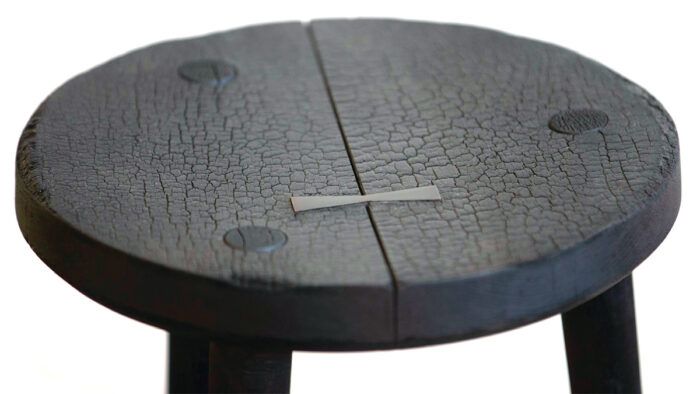How to Create a Charred Wood Furniture Finish
Christopher Miano shares an ancient Japanese technique that preserves wood by charring the surface.

Synopsis: Christopher Miano shares his method for shou sugi ban, an ancient Japanese technique that preserves wood by charring the surface. He’s used it with success on oak, cherry, and walnut. First he does several rounds of charring. Then he cools the wood, adds stain, and finishes with oil. A bronze butterfly key adds an extra touch.
In my studio I focus on traditional craft and techniques. Japanese joinery and construction have always inspired me, and through a process of trial and error I stumbled upon this method for my adaptation of shou sugi ban. Shou sugi ban is an ancient Japanese technique to preserve wood by charring the surface, creating a thin layer of carbon that protects the wood underneath in the same way that finish does. It was traditionally done on Japanese cedar, but I’ve used it with great success on oak, cherry, and walnut. My process involves charring the wood, cooling it, and finishing with a stain and then an oil.
Construction considerations and surface prep

For my stool I used solid red oak, because it is strong, affordable, and easily available. For the top of the stool I alternated end-grain orientation of the two parts that will be joined to avoid cupping over time and ensure a flat seat. Although the stool top is thick and has plenty of surface area for gluing, I prefer to shore up my glue-up with a few 10 x 50 Domino tenons to ensure that when I superheat the glue joint the boards won’t split apart. I add a bronze butterfly key to the joint to make it stronger and provide a design detail, gluing it in with Gorilla 5-minute, two-part epoxy.
Charring the surface
I always do the charring outside. Make sure you keep in mind the surface under the work you’re charring. Even if it is concrete or metal, for example, the charring will leave marks on it. And obviously you don’t want the surface you are charring on to be a flammable material. Be sure to keep a fire extinguisher handy just in case. As the son of a FDNY firefighter, I always take safety seriously.

My torch of choice is the SeeSii 500,000 BTU weed torch, connected to a propane tank. It was designed as a landscaping tool To stain or not to stain to remove weeds and can be picked up online or at a hardware store. I dial mine in to produce a constant flame and begin the three-step shou sugi ban process. Because the first step is a light surface charring, cooling time between the first two passes can be just a few hours, but after the second and third charring I wait overnight before I char again or apply finish.
Holding the torch 6 in. to 8 in. away from the stool, I start at the legs, charring the surface black and working my way up to the stool’s top. I’m searching for an alligator-scale look, but not on the first pass. The flame will heat up and begin to melt any glue, so try to work the areas around glue joints with caution. Keep the torch moving, particularly at glue joints. The Dominos in the top and butterfly will help with this process.

From Fine Woodworking #291
To view the entire article, please click the View PDF button below.
 |
An Exploration in Finishing |
 |
Ebonizing Oak with Steel Wool and Vinegar |
 |
Time-Tested Finishes that Just Work |
Fine Woodworking Recommended Products


Foam Brushes

Bahco 6-Inch Card Scraper








Comments
My understanding is that the kanji are more accurately transliterated as yaki sugi, not shou sugi ban. It might be worth including this point in the text in order to help those readers who want to search further.
Log in or create an account to post a comment.
Sign up Log in